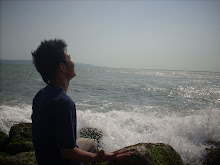Selasa, 22 Desember 2009
Poles Apart
The name Antartica was coined to mean “opposite to the arctic”. Antartica is a high, high- covered landmass. Arctic is the landmasses that grouped around the ice- covered Arctic Ocean. Because of this difference, the climate of the two areas is very different. If we attend in temperature sector, Antartica is the coldest areas in the world (about 30 degrees colder than Arctic). At the south pole, montly mean temperatures run below zero, but at near north pole mean temperatures often rise above freezing. At both poles, daily temperatures may drop far below monthly mean. The spectacular happened in August 1960, that world record for lower temperatures with -127 degrees Farenheit. Partly because of this climate difference, the land animals and plant of the two regions are very different. In Antartica, there are less of plant, but in Arctic, we can find more plant than in Antartica. In some of the few ice-free areas of Antartica, moses, lichens, and algae was found. Penguins do not exist in Arctic but populated in Antartica. Ice is the great feature of Antartica. So Antartica called with storehouse because about 85 percent of the total world supply of ice. If this great volume of ice were to melt, the volume of the world oceans would increase, and sea level would rice. Extreme atmospheric changes would have to take place for this to happen.
Green Revolution
Green revolution swept the world. It happened from 1950 to 1980. World food production doubled with the introduction of a new approach to agriculture. However green revolution method’s no longer appear to be so successful. The green revolution method’s no longer longer successful because of population continues to grow and cost of fertilizer for getting maximum production. Erosion is the reason for the lower grain production. In dry areas, especially, the loss of top soil has low productivity of the land. Grain production has been limited by the lack of water and new types of grain require more water than ordinary grain which we know. Social and political conflictn has interfered with food production. The problem lies in cost of new agricultural methods. Only the landowner can afford to make the necessary investments for maximum production of new grains. And now, it is time to question the methods of the green revolution. Farmers and goverment have to care and need to look at the overall picture and long term effects.
Langganan:
Postingan (Atom)

